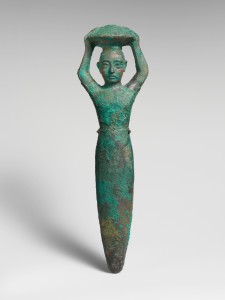Archaeological discoveries have allowed to identify the names of the ancient Mesopotamian rulers since the third millennium B.C. They substantially are three:
- En “Lord”
- Ensi (Akkadian ishshi’akkum) “governator”
- Lugal (Akkadian sharrum) “great man”
All three terms designate the sovereignty and authority of a single person on the government, but no one can be translated as “King”.They differ in:
- etymology
- meaning
- epoch
- geographical distribution
- power model
The oldest term is En, present on ideogrammatic texts of Uruk Level IV (full historic era). It designated the head of Uruk, husband of the goddess Inanna and held the temporal and spiritual power, a kind of priest-king. En often appeared anonymously on the inscriptions, just because husband of the goddess but know different En both legendary as Gilgamesh and historical as Ur-Ningirsu. In the third millennium, this term was also used elsewhere as Magan (on inscriptions of Naram-Sin) or at Ebla (in modern Syria) as the husband of Queen “maliktum“.
The term Ensi which is a compound of En seems instead to identify “the governor”. His logogram PA.TE.SI probabilmemte means “the one who holds the stick” of power or command. It appears for the first time in the texts of Adab and Fara. It is in the list of professions of Fara with word ensi.GAR-en-gal “the great Ensi: GAR”. At first the term Ensi designated sovereignty in the territory of Lagash (as Gudea of Lagash).
The term Ensi was used simultaneously to Lugal, so at first time it was thought that it was conditional. Lugal literally means “big man”, attested for the first time at the epoch of Uruk IIIb. In Ebla, instead Lugal, are subordinated the En. It seems that at some point the term Lugal has supplanted the term En stating a new concept of royalty linked to a warrior figure emphasizing the aspect of “owner”. So probably, put aside the term En, both the titling of Lugal and one of Ensi referred to the sovereignty and had equal role but while Ensi expresses a title, the lugal designates a function.
During the empire of Ur III kings, first of all Shulghi, used the term Lugal for himself and defined Ensi everyone else. This subordination of Ensi been established in the actual list of Lagash where it says that “An and Enlil created the Institute of Ensi before the kingship came down from heaven.”
Le scoperte archeologiche hanno permesso di identificare gli appellativi degli antichi sovrani mesopotamici a partire dal III millennio a.C. Essi sostanzialmente sono tre:
- En “Signore”
- Ensi (in accadico ishshi’akkum) “governatore”
- Lugal (in accadico sharrum) “grande uomo”
Tutti e tre i termini designano la sovranità e l’autorità di una singola persona sul governo ma nessuno può essere tradotto come “Re”. Essi differiscono tra loro per:
- etimologia
- significato
- epoca
- distribuzione geografica
- modello di potere
Il termine più antico è En, presente su testi ideogrammatici di Uruk lìvello IV (piena età protostorica). Esso designava il capo di Uruk, sposo della dea Inanna e deteneva il potere temporale e spirituale, una sorta di re-sacerdote. Spesso l’En appariva anonimo sulle iscrizioni, proprio perchè sposo della dea ma conosciamo diversi En sia leggendari come Gilgamesh sia storici come Ur-Ningirsu. Nel III millennio questo termine venne utilizzato anche altrove come Magan (su iscrizioni di Naram-Sin) o ad Ebla (nell’attuale Siria) come sposo della regina “maliktum“.
Il termine Ensi che è un composto di En sembra identificare invece “il governatore”. Il suo logogramma PA.TE.SI significa probabilmente “colui che detiene il bastone” del potere o comando. Appare per la prima volta nei testi di Adab e Fara. Esso è presente nella lista delle professioni di Fara con il termine en-si.GAR-gal “il grande Ensi:GAR”. In un primo momento il termine Ensi designava la sovranità nel territorio di Lagash (come Gudea di Lagash).
Il termine Ensi venne utilizzato contemporaneamente a Lugal, quindi in un primo momento si pensò che esso fosse subordinato. Lugal significa letteralmente “uomo grande”, attestato per la prima volta all’epoca di Uruk IIIb. Ad Ebla, invece i Lugal, sono subordinati all‘En. Sembra che ad un certo punto il termine Lugal abbia soppiantato il termine En affermando un nuovo concetto di regalità legata ad una figura guerriera sottolineando il suo aspetto di “proprietario”. Quindi probabilmente , messo da parte il termine En , sia la titolatura di Lugal che quella di Ensi facevano riferimento alla sovranità e avevano ruolo paritetico ma mentre l’Ensi esprime un titolo, il Lugal designa una funzione.
Durante l’impero di Ur III i sovrani, primo tra tutti Shulghi, utilizzarono il termine Lugal per sè e definirono Ensi tutti gli altri. Questa subordinazione degli Ensi viene sancita nella Lista reale di Lagash dove si dice che “An ed Enlil posero in essere l’Istituto dell’Ensi prima che la regalità scendesse dal cielo”.




